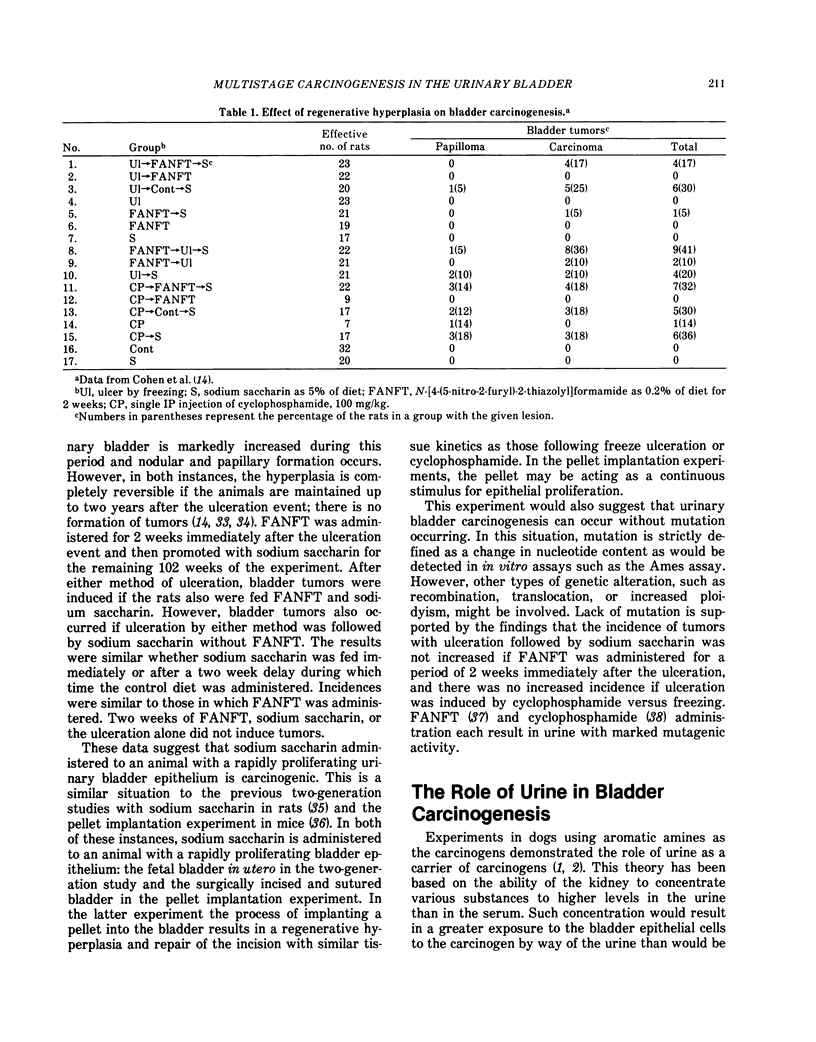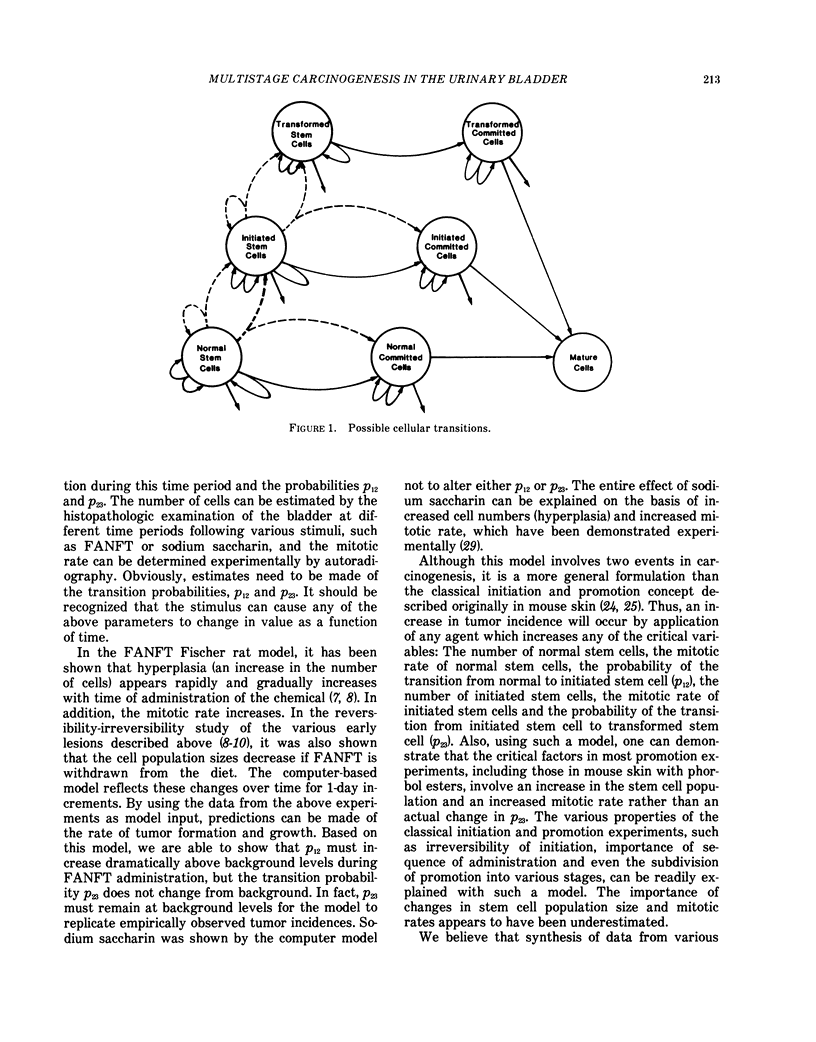Abstract
The induction of cancer of the urinary bladder is a multi-stage process involving multiple exogenous and endogenous factors. Based on the classical initiation-promotion model, we have used N-[4-(5-nitro-2-furyl)-2-thiazolyl]formamide (FANFT) as initiator and sodium saccharin (SAC) or tryptophan as promoters. These latter chemicals have the properties expected of promoters: induction of hyperplasia, reversibility and nonmutagenicity. Also, tumors were induced whether the promoter was administered immediately after FANFT or beginning 6 weeks after FANFT was discontinued, but no tumors resulted if either promoter was given without initiation with FANFT. Factor(s) present in normal urine also are involved in the promotion process, in addition to the role of urine as a carrier of carcinogens. However, administration of SAC to animals with a rapidly proliferating bladder mucosa, induced by ulceration, pellet insertion, or in utero, resulted in bladder tumor induction, even without prior initiation with FANFT. To better understand the complex interaction of the multiple variables in bladder carcinogenesis, a stochastic computer model has been formulated based on long-term carcinogenicity and tissue kinetic studies in vivo. This model indicates the importance of cell proliferation and the development of hyperplasia in carcinogenesis.
Full text
PDF






Selected References
These references are in PubMed. This may not be the complete list of references from this article.
- Arnold D. L., Moodie C. A., Grice H. C., Charbonneau S. M., Stavric B., Collins B. T., McGuire P. F., Zawidzka Z. Z., Munro I. C. Long-term toxicity of ortho-touenesulfonamide and sodium saccharin in the rat. Toxicol Appl Pharmacol. 1980 Jan;52(1):113–152. doi: 10.1016/0041-008x(80)90253-7. [DOI] [PubMed] [Google Scholar]
- BOUTWELL R. K. SOME BIOLOGICAL ASPECTS OF SKIN CARCINOGENISIS. Prog Exp Tumor Res. 1964;4:207–250. doi: 10.1159/000385978. [DOI] [PubMed] [Google Scholar]
- Babaya K., Miyata Y., Chmiel J. S., Oyasu R. Effects of rat urine fractionated by molecular weight on urinary bladder carcinogenesis. Cancer Res. 1982 Jan;42(1):15–18. [PubMed] [Google Scholar]
- Bryan G. T., Ertürk E., Yoshida O. Production of urinary bladder carcinomas in mice by sodium saccharin. Science. 1970 Jun 5;168(3936):1238–1240. doi: 10.1126/science.168.3936.1238. [DOI] [PubMed] [Google Scholar]
- Bryan G. T., Springberg P. D. Role of the vehicle in the genesis of bladder carcinomas in mice by the pellet implantation technic. Cancer Res. 1966 Jan;26(1):105–109. [PubMed] [Google Scholar]
- Chapman W. H., Kirchheim D., McRoberts J. W. Effect of the urine and calculus formation on the incidence of bladder tumors in rats implanted with paraffin wax pellets. Cancer Res. 1973 Jun;33(6):1225–1229. [PubMed] [Google Scholar]
- Clayson D. B., Cooper E. H. Cancer of the urinary tract. Adv Cancer Res. 1970;13:271–381. doi: 10.1016/s0065-230x(08)60168-2. [DOI] [PubMed] [Google Scholar]
- Clayson D. B., Lawson T. A., Pringle J. A. The carcinogenic action of 2-aminodiphenylene oxide and 4-aminodiphenyl on the bladder and liver of the C57 X IF mouse. Br J Cancer. 1967 Dec;21(4):755–762. doi: 10.1038/bjc.1967.88. [DOI] [PMC free article] [PubMed] [Google Scholar]
- Cohen S. M., Arai M., Jacobs J. B., Friedell G. H. Promoting effect of saccharin and DL-tryptophan in urinary bladder carcinogenesis. Cancer Res. 1979 Apr;39(4):1207–1217. [PubMed] [Google Scholar]
- Cohen S. M., Murasaki G., Fukushima S., Greenfield R. E. Effect of regenerative hyperplasia on the urinary bladder: carcinogenicity of sodium saccharin and N-[4-(5-nitro-2-furyl)-2-thiazolyl]formamide. Cancer Res. 1982 Jan;42(1):65–71. [PubMed] [Google Scholar]
- Druckrey H., Preussmann R., Ivankovic S., Schmähl D. Organotrope carcinogene Wirkungen bei 65 verschiedenen N-Nitroso-Verbindungen an BD-Ratten. Z Krebsforsch. 1967;69(2):103–201. [PubMed] [Google Scholar]
- Ertürk E., Cohen S. M., Price J. M., Bryan G. T. Pathogenesis, histology, and transplantability of urinary bladder carcinomas induced in albino rats by oral administration of N-(4-(5-nitro-2-furyl)-2-thiazolyl)formamide. Cancer Res. 1969 Dec;29(12):2219–2228. [PubMed] [Google Scholar]
- Ertürk E., Price J. M., Morris J. E., Cohen S., Leith R. S., Von Esch A. M., Crovetti A. J. The production of carcinoma of the urinary bladder in rats by feeding N-[3-(5-nitro-2-furyl)-2-thiazolyl]formamide. Cancer Res. 1967 Nov;27(11):1998–2002. [PubMed] [Google Scholar]
- Fukushima S., Arai M., Cohen S. M., Jacobs J. B., Friedell G. H. Scanning electron microscopy of cyclophosphamide-induced hyperplasia of the rat urinary bladder. Lab Invest. 1981 Feb;44(2):89–96. [PubMed] [Google Scholar]
- Fukushima S., Cohen S. M., Arai M., Jacobs J. B., Friedell G. H. Scanning electron microscopic examination of reversible hyperplasia of the rat urinary bladder. Am J Pathol. 1981 Mar;102(3):373–380. [PMC free article] [PubMed] [Google Scholar]
- Fukushima S., Cohen S. M. Saccharin-induced hyperplasia of the rat urinary bladder. Cancer Res. 1980 Mar;40(3):734–736. [PubMed] [Google Scholar]
- Fukushima S., Friedell G. H., Jacobs J. B., Cohen S. M. Effect of L-tryptophan and sodium saccharin on urinary tract carcinogenesis initiated by N-[4-(5-nitro-2-furyl)-2-thiazolyl]formamide. Cancer Res. 1981 Aug;41(8):3100–3103. [PubMed] [Google Scholar]
- Hicks R. M., Chowaniec J. The importance of synergy between weak carcinogens in the induction of bladder cancer in experimental animals and humans. Cancer Res. 1977 Aug;37(8 Pt 2):2943–2949. [PubMed] [Google Scholar]
- Hicks R. M., Wakefield J. S. Rapid induction of bladder cancer in rats with N-methyl-N-nitrosourea. I. Histology. Chem Biol Interact. 1972 Jul;5(2):139–152. doi: 10.1016/0009-2797(72)90040-3. [DOI] [PubMed] [Google Scholar]
- Izumi K., Hirao Y., Hopp L., Oyasu R. In vitro induction of ornithine decarboxylase in urinary bladder carcinoma cells. Cancer Res. 1981 Feb;41(2):405–409. [PubMed] [Google Scholar]
- Jacobs J. B., Arai M., Cohen S. M., Friedell G. H. A long-term study of reversible and progressive urinary bladder cancer lesions in rats fed N-[4-(5-nitro-2-furyl)-2-thiazolyl]formamide. Cancer Res. 1977 Aug;37(8 Pt 2):2817–2821. [PubMed] [Google Scholar]
- Jacobs J. B., Arai M., Cohen S. M., Friedell G. H. Early lesions in experimental bladder cancer: scanning electron microscopy of cell surface markers. Cancer Res. 1976 Jul;36(7 Pt 2):2512–2517. [PubMed] [Google Scholar]
- Jacobs J. B., Arai M., Cohen S. M., Friedell G. H. Light and scanning electron microscopy of exfoliated bladder epithelial cells in rats fed N-(4-(5-nitro-2-furyl)-2-thiazolyl)formamide. J Natl Cancer Inst. 1976 Jul;57(1):63–66. doi: 10.1093/jnci/57.1.63. [DOI] [PubMed] [Google Scholar]
- Kinsella A. R., Radman M. Tumor promoter induces sister chromatid exchanges: relevance to mechanisms of carcinogenesis. Proc Natl Acad Sci U S A. 1978 Dec;75(12):6149–6153. doi: 10.1073/pnas.75.12.6149. [DOI] [PMC free article] [PubMed] [Google Scholar]
- Mohn G. R., Ellenberger J. Genetic effects of cyclophosphamide, ifosfamide and trofosfamide. Mutat Res. 1976;32(3-4):331–360. doi: 10.1016/0165-1110(76)90005-1. [DOI] [PubMed] [Google Scholar]
- Moore C. W., Schmick A. Genetic effects of impure and pure saccharin in yeast. Science. 1979 Sep 7;205(4410):1007–1010. doi: 10.1126/science.382356. [DOI] [PubMed] [Google Scholar]
- Nakanishi K., Hagiwara A., Shibata M., Imaida K., Tatematsu M., Ito N. Dose response of saccharin in induction of urinary bladder hyperplasias in Fischer 344 rats pretreated with N-butyl-N-(4-hydroxybutyl)nitrosamine. J Natl Cancer Inst. 1980 Nov;65(5):1005–1010. [PubMed] [Google Scholar]
- Nakanishi K., Hirose M., Ogiso T., Hasegawa R., Arai M., Ito N. Effects of sodium saccharin and caffeine on the urinary bladder of rats treated with n-butyl-n-(4-hydroxybutyl)nitrosamine. Gan. 1980 Aug;71(4):490–500. [PubMed] [Google Scholar]
- Oyasu R., Hirao Y., Izumi K. Enhancement by urine of urinary bladder carcinogenesis. Cancer Res. 1981 Feb;41(2):478–481. [PubMed] [Google Scholar]
- Radomski J. L., Glass E. M., Deichmann W. B. Transitional cell hyperplasia in the bladders of dogs fed DL-tryptophan. Cancer Res. 1971 Nov;31(11):1690–1694. [PubMed] [Google Scholar]
- Rowland R. G., Henneberry M. O., Oyasu R., Grayhack J. T. Effects of urine and continued exposure to carcinogen on progression of early neoplastic urinary bladder lesions. Cancer Res. 1980 Dec;40(12):4524–4527. [PubMed] [Google Scholar]
- Scribner J. D., Süss R. Tumor initiation and promotion. Int Rev Exp Pathol. 1978;18:137–198. [PubMed] [Google Scholar]
- Tatematsu M., Miyata Y., Mizutani M., Hananouchi M., Hirose M. Summation effect of N-butyl-n-(4-hydroxybutyl)nitrosamine, N-(4-(5-nitro-2-furyl)-2-thiazoly)formamide, N-2-fluoroenylacetamide, and 3,3'-dichlorobenzidine on urinary bladder carcinogenesis in rats. Gan. 1977 Apr;68(2):193–202. [PubMed] [Google Scholar]
- Tiltman A. J., Friedell G. H. Effect of feeding N-(4-(5-nitro-2-furyl)-2-thiazolyl)formamide on mitotic activity of rat urinary-bladder epithelium. J Natl Cancer Inst. 1972 Jan;48(1):125–129. [PubMed] [Google Scholar]
- Tiltman A. J., Friedell G. H. The histogenesis of experimental bladder cancer. Invest Urol. 1971 Nov;9(3):218–226. [PubMed] [Google Scholar]
- Tsuda H., Miyata Y., Murasaki G., Kinoshita H., Fukushima S. Synergistic effect of urinary bladder carcinogenesis in rats treated with N-butyl-n-(4-hydroxybutyl)nitrosamine, N-(4-(5-nitro-2-furyl)-2-thiazolyl)formamide,N-2-fluorenylacetamide, and 3,3'-dichlorobenzidine. Gan. 1977 Apr;68(2):183–192. [PubMed] [Google Scholar]
- Warwick G. P. Effect of the cell cycle on carcinogenesis. Fed Proc. 1971 Nov-Dec;30(6):1760–1765. [PubMed] [Google Scholar]


